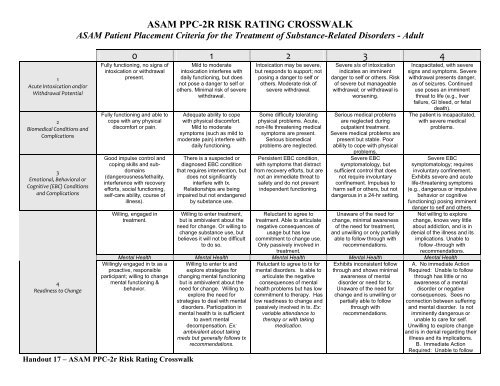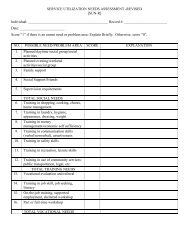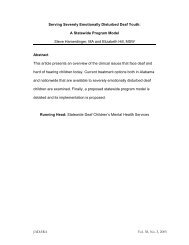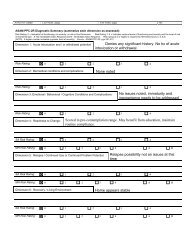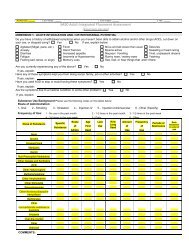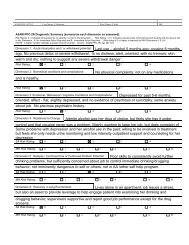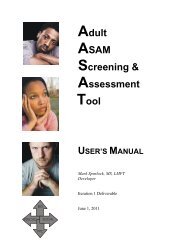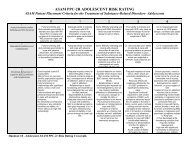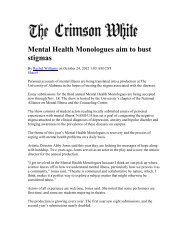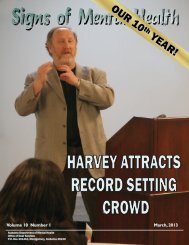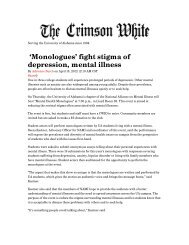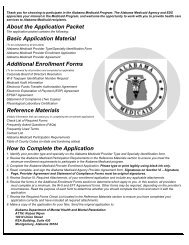ASAM PPC-2r Risk Rating Crosswalk - Alabama Department of ...
ASAM PPC-2r Risk Rating Crosswalk - Alabama Department of ...
ASAM PPC-2r Risk Rating Crosswalk - Alabama Department of ...
Create successful ePaper yourself
Turn your PDF publications into a flip-book with our unique Google optimized e-Paper software.
1<br />
Acute Intoxication and/or<br />
Withdrawal Potential<br />
2<br />
Biomedical Conditions and<br />
Complications<br />
3<br />
Emotional, Behavioral or<br />
Cognitive (EBC) Conditions<br />
and Complications<br />
4<br />
Readiness to Change<br />
<strong>ASAM</strong> <strong>PPC</strong>-2R RISK RATING CROSSWALK<br />
<strong>ASAM</strong> Patient Placement Criteria for the Treatment <strong>of</strong> Substance-Related Disorders - Adult<br />
Handout 17 – <strong>ASAM</strong> <strong>PPC</strong>-<strong>2r</strong> <strong>Risk</strong> <strong>Rating</strong> <strong>Crosswalk</strong><br />
0 1 2 3 4<br />
Fully functioning, no signs <strong>of</strong><br />
intoxication or withdrawal<br />
present.<br />
Fully functioning and able to<br />
cope with any physical<br />
discomfort or pain.<br />
Good impulse control and<br />
coping skills and subdomains<br />
(dangerousness/lethality,<br />
interference with recovery<br />
efforts, social functioning,<br />
self-care ability, course <strong>of</strong><br />
illness).<br />
Willing, engaged in<br />
treatment.<br />
Mild to moderate<br />
intoxication interferes with<br />
daily functioning, but does<br />
not pose a danger to self or<br />
others. Minimal risk <strong>of</strong> severe<br />
withdrawal.<br />
Adequate ability to cope<br />
with physical discomfort.<br />
Mild to moderate<br />
symptoms (such as mild to<br />
moderate pain) interfere with<br />
daily functioning.<br />
There is a suspected or<br />
diagnosed EBC condition<br />
that requires intervention, but<br />
does not significantly<br />
interfere with tx.<br />
Relationships are being<br />
impaired but not endangered<br />
by substance use.<br />
Willing to enter treatment,<br />
but is ambivalent about the<br />
need for change. Or willing to<br />
change substance use, but<br />
believes it will not be difficult<br />
to do so.<br />
Intoxication may be severe,<br />
but responds to support; not<br />
posing a danger to self or<br />
others. Moderate risk <strong>of</strong><br />
severe withdrawal.<br />
Some difficulty tolerating<br />
physical problems. Acute,<br />
non-life threatening medical<br />
symptoms are present.<br />
Serious biomedical<br />
problems are neglected.<br />
Persistent EBC condition,<br />
with symptoms that distract<br />
from recovery efforts, but are<br />
not an immediate threat to<br />
safety and do not prevent<br />
independent functioning.<br />
Reluctant to agree to<br />
treatment. Able to articulate<br />
negative consequences <strong>of</strong><br />
usage but has low<br />
commitment to change use.<br />
Only passively involved in<br />
treatment.<br />
Severe s/s <strong>of</strong> intoxication<br />
indicates an imminent<br />
danger to self or others. <strong>Risk</strong><br />
<strong>of</strong> severe but manageable<br />
withdrawal; or withdrawal is<br />
worsening.<br />
Serious medical problems<br />
are neglected during<br />
outpatient treatment.<br />
Severe medical problems are<br />
present but stable. Poor<br />
ability to cope with physical<br />
problems.<br />
Severe EBC<br />
symptomatology, but<br />
sufficient control that does<br />
not require involuntary<br />
confinement. Impulses to<br />
harm self or others, but not<br />
dangerous in a 24-hr setting.<br />
Unaware <strong>of</strong> the need for<br />
change, minimal awareness<br />
<strong>of</strong> the need for treatment,<br />
and unwilling or only partially<br />
able to follow through with<br />
recommendations.<br />
Incapacitated, with severe<br />
signs and symptoms. Severe<br />
withdrawal presents danger,<br />
as <strong>of</strong> seizures. Continued<br />
use poses an imminent<br />
threat to life (e.g., liver<br />
failure, GI bleed, or fetal<br />
death).<br />
The patient is incapacitated,<br />
with severe medical<br />
problems.<br />
Severe EBC<br />
symptomatology; requires<br />
involuntary confinement.<br />
Exhibits severe and acute<br />
life-threatening symptoms<br />
(e.g., dangerous or impulsive<br />
behavior or cognitive<br />
functioning) posing imminent<br />
danger to self and others.<br />
Not willing to explore<br />
change, knows very little<br />
about addiction, and is in<br />
denial <strong>of</strong> the illness and its<br />
implications. Unable to<br />
follow -through with<br />
recommendations.<br />
Mental Health Mental Health Mental Health Mental Health Mental Health<br />
Willingly engaged in tx as a<br />
proactive, responsible<br />
participant; willing to change<br />
mental functioning &<br />
behavior.<br />
Willing to enter tx and<br />
explore strategies for<br />
changing mental functioning<br />
but is ambivalent about the<br />
need for change. Willing to<br />
explore the need for<br />
strategies to deal with mental<br />
disorders. Participation in<br />
mental health tx is sufficient<br />
to avert mental<br />
decompensation. Ex:<br />
ambivalent about taking<br />
meds but generally follows tx<br />
recommendations.<br />
Reluctant to agree to tx for<br />
mental disorders. Is able to<br />
articulate the negative<br />
consequences <strong>of</strong> mental<br />
health problems but has low<br />
commitment to therapy. Has<br />
low readiness to change and<br />
passively involved in tx. Ex:<br />
variable attendance to<br />
therapy or with taking<br />
medication.<br />
Exhibits inconsistent follow<br />
through and shows minimal<br />
awareness <strong>of</strong> mental<br />
disorder or need for tx.<br />
Unaware <strong>of</strong> the need for<br />
change and is unwilling or<br />
partially able to follow<br />
through with<br />
recommendations.<br />
A. No immediate Action<br />
Required: Unable to follow<br />
through has little or no<br />
awareness <strong>of</strong> a mental<br />
disorder or negative<br />
consequences. Sees no<br />
connection between suffering<br />
and mental disorder. Is not<br />
imminently dangerous or<br />
unable to care for self.<br />
Unwilling to explore change<br />
and is in denial regarding their<br />
illness and its implications.<br />
B. Immediate Action<br />
Required: Unable to follow
5<br />
Relapse, Continued Use, or<br />
Continued Problem Potential<br />
6<br />
Recovery Environment<br />
Low or no potential for<br />
relapse, good coping skills.<br />
Handout 17 – <strong>ASAM</strong> <strong>PPC</strong>-<strong>2r</strong> <strong>Risk</strong> <strong>Rating</strong> <strong>Crosswalk</strong><br />
Minimal relapse potential,<br />
with some vulnerability, and<br />
has fair self management<br />
and relapse prevention skills.<br />
Impaired recognition and<br />
understanding <strong>of</strong> substance<br />
use relapse issues, but is<br />
able to self manage with<br />
prompting.<br />
Little recognition and<br />
understanding <strong>of</strong> substance<br />
use relapse issues, and poor<br />
skills to interrupt addiction<br />
problems, or to avoid or limit<br />
relapse.<br />
through with<br />
recommendations. Behavior<br />
represents an imminent<br />
danger <strong>of</strong> harm to self and<br />
others. Unable to function<br />
independently or engage in<br />
self-care.<br />
No skills to cope with<br />
addiction problems, or to<br />
prevent relapse. Continued<br />
addictive behavior places<br />
self and/or others in<br />
imminent danger.<br />
Mental Health Mental Health Mental Health Mental Health Mental Health<br />
No potential for further<br />
mental health problems or<br />
low potential and good<br />
coping skills.<br />
Supportive environment<br />
and/or able to cope in<br />
environment.<br />
Minimal relapse potential<br />
with some vulnerability and<br />
fair self management &<br />
relapse prevention skills.<br />
Passive support or<br />
significant others are not<br />
interested in patient’s<br />
addiction recovery, but is<br />
not too distracted by this<br />
and is able to cope<br />
Impaired recognition &<br />
understanding <strong>of</strong> mental<br />
illness relapse issues, but is<br />
able to self-manage.<br />
The environment is not<br />
supportive <strong>of</strong> addiction<br />
recovery but, with clinical<br />
structure, able to cope most<br />
<strong>of</strong> the time.<br />
Little recognition or<br />
understanding <strong>of</strong> mental<br />
illness relapse issues & poor<br />
skills to cope with mental<br />
health problems.<br />
The environment is not<br />
supportive <strong>of</strong> addiction<br />
recovery and the patient<br />
finds coping difficult, even<br />
with clinical structure.<br />
A. No immediate action<br />
required: Repeated tx<br />
episodes with little positive<br />
effect. No skills to cope with<br />
or interrupt mental health<br />
problems. Not in imminent<br />
danger and is able to care for<br />
self.<br />
B. Immediate action required:<br />
No skills to arrest the mental<br />
health disorder or relapse <strong>of</strong><br />
mental illness. Psychiatric<br />
disorder places them in<br />
imminent danger.<br />
The environment is<br />
chronically hostile and<br />
toxic to recovery. The<br />
patient is unable to cope<br />
with the negative effects<br />
<strong>of</strong> this environment on<br />
recovery, and the<br />
environment may pose a<br />
threat to the patient’s<br />
safety.<br />
Mental Health Mental Health Mental Health Mental Health Mental Health<br />
Has a supportive<br />
environment or is able to<br />
cope with poor supports.<br />
Has passive supports or<br />
significant others not<br />
interested in improved<br />
mental health but they are<br />
able to cope.<br />
Environment is not<br />
supportive <strong>of</strong> good mental<br />
health but, with clinical<br />
structure, they are able to<br />
cope most <strong>of</strong> the time.<br />
Environment is not<br />
supportive <strong>of</strong> good mental<br />
health and they find coping<br />
difficult, even with clinical<br />
structure.<br />
A. No immediate action<br />
required: Environment is not<br />
supportive and is chronically<br />
hostile and toxic to good<br />
mental health Able to cope<br />
with the negative effects <strong>of</strong><br />
the environment on their<br />
recovery.<br />
B. Immediate Action<br />
Required: Environment is not<br />
supportive and is chronically<br />
hostile to a safe mental<br />
health environment posing<br />
an immediate threat to their<br />
safety and well being. (ex
No <strong>Risk</strong> Low Moderate High<br />
lives with a abusive<br />
alcoholic partner.)<br />
Severe<br />
�<br />
�<br />
��Level III Residential Treatment typically has a one “3” or “4” in Dimension 1, 2 or 3; and an additional “3” or “4” in Dimensions 1 through 6. For dimension 1, risk<br />
rating <strong>of</strong> “3” or “4” within past 2 weeks.<br />
��Level II Partial Hospitalization typically has a risk rating <strong>of</strong> “1” or “0” in Dimension 1; a “2” or “3” in Dimension 2; a “2 or 3” in Dimension 3; and one “3 or 4” in<br />
Dimensions 4 through 6.<br />
��Level II Intensive Outpatient typically has a “0” or “1” in Dimensions 1 and 2; a “1 or 2” in Dimension 3; and a “3” or “4” in Dimension 4, 5, or 6.<br />
��Level I Outpatient treatment typically has a risk rating <strong>of</strong> “0” or”1” in all Dimensions.<br />
Handout 17 – <strong>ASAM</strong> <strong>PPC</strong>-<strong>2r</strong> <strong>Risk</strong> <strong>Rating</strong> <strong>Crosswalk</strong><br />
This document is a reference guide only and not an <strong>of</strong>ficial publication <strong>of</strong> the American Society <strong>of</strong> Addiction Medicine, Inc.


